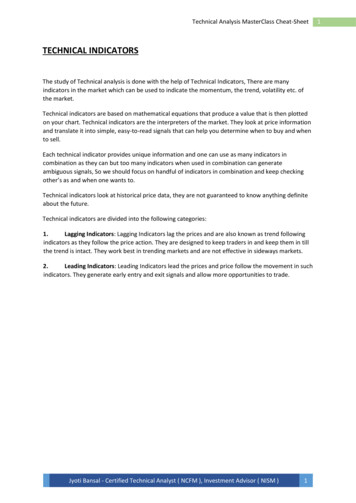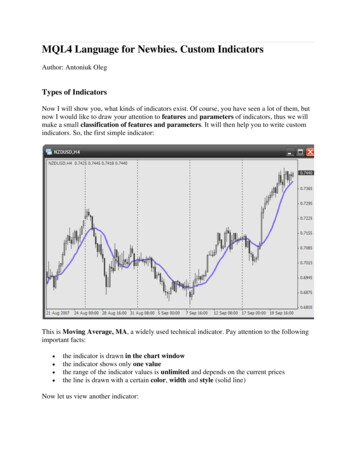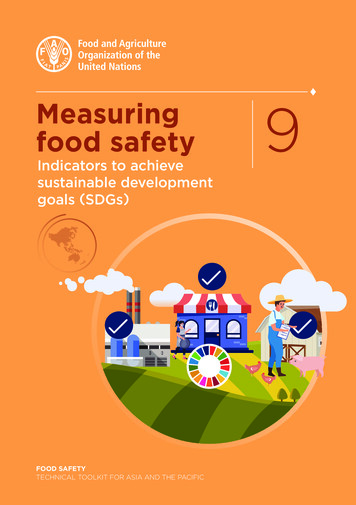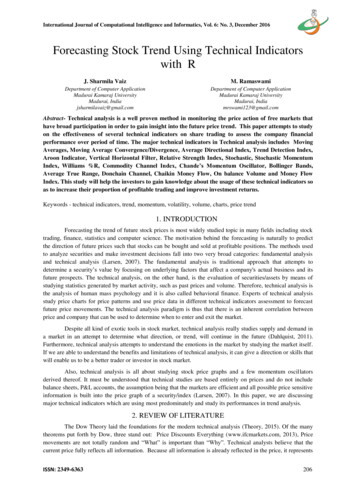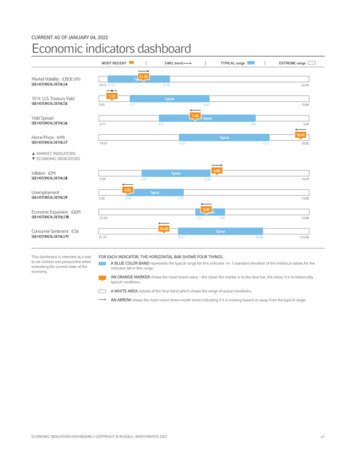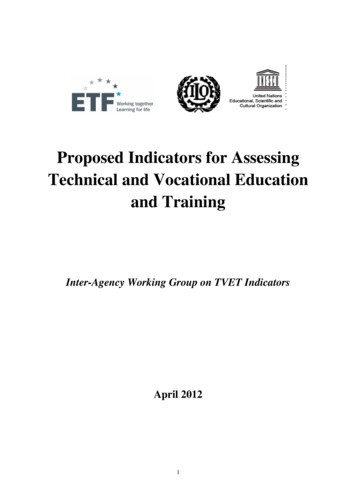
Transcription
Proposed Indicators for AssessingTechnical and Vocational Educationand TrainingInter-Agency Working Group on TVET IndicatorsApril 20121
I. Introduction . 3II. Conceptual framework . 5III. TVET indicators . 9III.1. Indicators measuring finance . 12III.2. Indicators measuring access and participation. 16III.3. Quality and innovation indicators. 22III.4. Relevance of TVET: measuring labour market transitions . 27IV. Using indicators for TVET policy design. 38IV.1. Designing country-specific policies and indicators. 38IV.2. Dealing with and assessing data sources . 39IV.3. Capacity building and using the indicators for policy-design . 43V. Concluding remarks and recommendations . 46References. 48Annex: General context indicators . 502
I. IntroductionThis paper draws together the work on conceptual clarification and methodologicalapproaches on developing indicators for monitoring and evaluating Technical and VocationalEducation and Training (TVET) developed by the Inter-agency Group on TVET (IAGTVET). The IAG-TVET was established in 2009 with the aim of coordinating activities of theagencies active in the field of TVET particularly in developing countries. It comprises theUnited Nations Educational, Scientific and Cultural Organisation (UNESCO), theOrganisation for Economic Co-operation and Development (OECD), the World Bank (WB),the International Labour Organisation (ILO), the European Commission (EC), the EuropeanTraining Foundation (ETF) and the Asian Development Bank (ADB).This joint work comes at a significant time of challenge and opportunity for TVET. Technicaland vocational education and training strategies and policies are receiving renewed attention.Through its diverse forms, many policymakers see TVET as potentially making a differenceto individuals, enterprises, communities and societies at large.However, TVET is a diverse sector. It comprises formal, non-formal and informal learning. Ittakes place across a wide range of settings including schools, public and private vocationalcenters and institutes, higher education institutions and workplaces in both the formal andinformal economies. TVET also has a multitude of very different institutional arrangements,organisational approaches and regulations.Recent years have seen an increased interest in evidence-based policy making in TVET anduse of valid and robust evaluation and monitoring instruments and indicators. However, thereare several longstanding problems related to monitoring and evaluating TVET. These include,among others, the fragmented provision of TVET in many countries, the variousmethodological challenges related to definition of TVET programmes and generation ofrelevant indicators and the absence of adequate mechanisms to collect, process and aggregatedata available.It is against this background that the IAG-TVET established a Working Group on TVETIndicators (WGI) in 2010 to make recommendations on a set of TVET indicators that cansupport countries assess the efficiency and effectiveness of national TVET systems, with aparticular focus on low-income countries. The primary purpose of the Working Group is tostrengthen the ability of national governments of developing countries to design, monitor andevaluate their TVET sectors. The Working Group also benefited from input from theUNESCO Institute for Statistics, the German Federal Ministry for Economic Cooperation andDevelopment (BMZ) and the Deutsche Gesellschaft für Internationale Zusammenarbeit(GIZ).3
The WGI mapped the indicators commonly collected or used by the internationalorganizations in an initial phase and then identified five pertinent policy areas: Access andparticipation; Relevance; Quality and innovation in TVET; Governance and TVET Financing.The detailed conceptual framework of these policy areas is presented in the next section.In developing a set of indicators to monitor TVET, it is important to underscore that thepreliminary list of indicators presented in this report is a work in progress and that, afterfurther consultation and piloting in different countries, it will likely be refined based on dataavailability, country priorities, and other considerations.The report is organized into three main parts. The first part presents the conceptualframework used to develop the five broad policy areas and describes their scope.The second part focuses on the main indicators for each policy area. A range of indicators isproposed covering fundamental indicators for which data is available, fundamental indicatorsfor which data is difficult to obtain in the context of developing countries and other indicatorswhich are desirable in terms of the data they contain but which may not be widely available.The third part suggests that monitoring and evaluating TVET requires national ownershipand capacity development. It pays attention to ways for strengthening national institutions inthe field.4
II. Conceptual frameworkIn view of the diversity of TVET provision in developing countries, different types of TVETcan be examined separately wherever possible. For example, the following types of TVETmay be used and different indicators considered for different types of TVET provision.Figure 1: Typology of TVET provision1. Institution(i) Provided by the formal (a) Under the supervision of thebased training education systemMinistry of Education(b) Outside the supervision of theMinistry of Education(ii) Provided outside the(a) Publicformal education system(b) Non-publicFor profitNot for profit2. Workplace- (i) Pre-employment(a) Modern apprenticeshipbased training training(b) Traditional apprenticeship(ii) In-service training3. Combination of multiple types of training (e.g. sandwich programs, dual systems)Monitoring and evaluating TVET performance and identifying the possibilities for improvingits quality and coverage require an understanding of the nature of TVET, its functions, goalsand key characteristics.To shape and organise the discussion, the WGI developed a conceptual framework thatconsiders key interlocking components and related policy areas: Relevance, access andparticipation, quality, finance and governance. Each component can add substance to ongoing policy dialogue and help define indicators on TVET performance.The conceptual framework set-out in figure 2 builds on the assumption that policymakers andstakeholders have to optimally combine priorities related to the first three components(Relevance, equity, quality) giving financial resource available within a given context ofinstitutional settings and governance.5
Figure 2: Conceptual framework for selected policy areasThe components for monitoring and evaluating TVET policies and reform are summarised inthe table below.6
Table 1: Interlocking components for monitoring and evaluating TVET performanceGovernance contextGovernance considers the extent to which TVET system, across all levels and in all thevarious sub-parts, is characterised by participation, transparency and accountability.Governance also raises questions concerning quality assurance and multiple voices,because new actors are assuming responsibility and taking part in decisions.Governance structure is largely dependent on institutional arrangements and the respectiveroles of key stakeholders. Such considerations ultimately encourage questions about theroles that governance systems play in generating and steering the relevance, access andparticipation and quality/innovation components for delivery of specific models of TVETand within the available resources.Component 1: FinanceTVET financing is largely determined by the rules and regulations whereby financialresources are collected, allocated, and managed. It largely depends on the economicsituation and available resources, but also on the priority levels that decision makers ofvarious types of TVET have with regard to relevance, equity and quality; and on the tradeoffs stemming from those priorities. This component equally looks at capacity of thesystem to ensure that resources are equitable and efficiently allocated.Component 2: Access and participationThis component considers the extent to which various types of TVET promote equity andinclusion and the implications on expanding learning opportunities for excluded groups.This is examined through the lens of access and participation. While this secondcomponent focuses on important social aims of TVET, it simultaneously has a strongrelation to the relevance dimension as it prioritizes increasing the numbers of people withviable and effective opportunities to benefit from high quality TVET leading to labourmarket outcomes.Component 3: QualityThis component addresses the policy options leading to a TVET system focused on theteaching and learning process and its effectiveness. It is a measure of the quality of anyTVET programme, that it is effectively conducted and relevant in terms of meeting skillneeds. Quality facilities and equipment is also fundamental to the provision of qualityTVET. Equally important, this component looks at the capacity of the systems to innovateand how teaching and learning process is a site of innovation itself, for example with rapid7
changes in the use of information and communication technologies. The componentequally looks at the availability of a systematic approach to quality assurance in order tosupport practitioners and policy-makers in improving the quality of training provision, andalso guide students in making choices.Component 4: RelevanceThis component considers the extent to which TVET is responsive to labour market needsand requirements. The related policy area to be considered here are labour market links toTVET programmes and outcomes of the TVET programmes. This component reflects theassumption that the primary and key role of TVET is to raise skills levels and to helpmatching skills needs at all levels in today’s complex and changing labour markets.Relevance also entails the mechanisms and available capacity to understand transitionfrom school and all types of TVET programmes to work as well as to capture labourmarket signals and to anticipate emerging skills needs and the extent to which this informsTVET provision.8
III. TVET indicatorsThe proposed indicators help in benchmarking the TVET sector. Benchmarking helps inlinking the internal processes to external expectations, to develop appropriate internalmechanisms for the enhancement of TVET quality and effectiveness, respectively to comparethe results with good practices elsewhere or with national goals.Three categories of indicators are proposed. The categories reflect the expected feasibility andavailability of indicators: the first cover indicators, that are most likely to be readily availableand the next two columns contain indicators, which would be desirable as they complementthe information provided by the first category, but which are not expected to be as readilyavailable in developing countries. References to formal education and training should not beseen as minimising the role and importance of non-formal and informal education andtraining. These references merely demonstrate the difficulties of getting reliable data on nonformal and informal education and training.9
Table 2: Categories and types of indicators used in TVET evaluationThis list is work-in-progress and is subject to change by WG member organizations during the field testing.AreaData readily available1.1 Spending in formal TVETIndicators and data availabilityData not readily availableData often not available1.3 Share of companies providing1.2 Total TVET spending byapprenticeship and other types of trainingstudent(by size of the company)1.4 Share of apprenticeship and othertypes of training spending in labour cost(by size of the company)1. Financing2. AccessAccess asopportunitiesAccess as participation2.1 Enrolment in vocational educationas a percentage of total enrolment inthe formal education system.2.6 Typology of AdmissionPolicies to formal school-basedTVET2.2. Enrolment by type of TVETprogramme2.7 Transition paths from uppersecondary TVET education3.1 Student/teacher ratio in formalTVET and in general programmes3.3 Share of apprenticescompleting registeredprogrammes as a percentage of allapprentices starting registeredprogrammes2.3 Work-based learning participationrate2.4 Equity2.5 Unsatisfied demand for TVET2.8 Policies on articulation withschooling/higher educationAccess as transition3. Quality andInnovation3.2 Completion rate in TVETprogrammes and in generalprogrammes3.4 Share of qualified teachers inTVET and in general programmes103.5 Relevance of quality assurancesystems for TVET providers3.6 Investment in training of teachers andtrainers3.7 Utilisation of acquired skills at theworkplace3.8 Share of ICT training activities inTVET3.9 Satisfaction of employers with TVETgraduates
4. Relevance4.1 Employment to population ratio4.2 Unemployment rate4.3 Employment status4.4 Employment by economic sector4.5 Employment by occupation4.6 Literacy rate4.7 Informal employment rate4.8 Time-related unemploymentrate114.9 Working poverty rate4.10 Average real earnings4.11 Number of vacant jobs4.12 Net job creation4.13 Youth outside labour force4.14 Discouraged workers
III.1. Indicators measuring financeWhile the access, labour market outcomes and the quality indicators measure the effectivenessof the system, the financial resources allocated to TVET programmes express their efficiencyas well as policy priorities and trade-offs. In this sense the analysis should integratequantitative and qualitative information, interpreting financing choices and mechanisms fromthe point of view of aims underpinning national TVET policies and final impacts.Many countries have to reconcile limited public and private resources with the need to spreadthem over many levels and programmes. A key policy issue is therefore how to achieve thebest use of resources, while ensuring a sustainable budget. As a consequence, the policydebate increasingly focuses on augmenting the volume of financing through diversification,but equally on efficiency while ensuring equity. Diversification happens mainly by engagingenterprises, individuals and other innovative sources of funding (philanthropic, sponsors, etc.)and through public–private partnerships. The formal apprenticeship system represents anillustration of public-private partnership in which different actors play their own roles in thefinancing mechanisms. The system works through interaction between public institutions(central, regional or local), which contribute to financing the school-based part of training,and the enterprises that contribute to financing the company-based component.At the same time, acting on the twin themes of efficiency and equity means that financingpolicies and mechanisms need to ensure that equity and efficiency complement each other.This comes with an emphasis on assuring that further developments of TVET systems meetthe needs of the excluded (UNESCO, 2010), in particular early school leavers, low skilledpersons, migrants, persons with disabilities and the unemployed.It is important for TVET financing to distinguish (in general) between sources of funds andhow these funds are allocated and to which programmes and then used. In other words, thedistinction should be made between resource mobilisation, resource allocation, respectivelyresource utilisation.Resource mobilization varies significantly from country to country. Thus, a first step is todescribe precisely the various financing schemes for the different types of TVETprogrammes. This guarantees that the country’s characteristics are well captured and that thebasic common features (of all TVET systems) are sufficiently described. These commoncharacteristics include:(i) whether training levies are in place (i.e. taxes on company payrolls, which can berecovered through agreed training expenditures);(ii) the scope of funding system and type of TVET programmes funded(iii) the existence of student fees (cost-sharing);(iv) the existence of a TVET fund. Moreover, this area, in developing countries, shouldcover the level of donor funding as a percentage of total TVET funding;12
(v) In-kind contributions to the TVET system, especially in countries where traditionalapprenticeship is a major element of TVET.The resource allocation mechanisms to different institutions involved in the TVET systemshould be studied. The utilisation of resources depends on the administrative system andgovernment regulations under which TVET institutions operate. The overall governancestructure impacts the effectiveness of the available resources. The policy issue here is to whatextent the system in place provides incentives and flexibility to TVET institutions, companies,communities and individuals to use their (often limited) resources in the most efficient andeffective way.Relevant indicators depend on the coverage and scope of public and private funding of thevarious types of TVET programmes. For example, calculating the percentage of formal TVETspending to total education spending would be less relevant in a country where the majority ofTVET programmes are provided outside of the formal education and training system.Hence, as discussed in the access and participation section., it is important to start by amapping of available TVET programmes and work to capture financial data such asexpenditure on personnel services; maintenance and operating costs; capital expenditures; andother services provided to trainees. Mapping could also include items on financial resourcessuch as budget for training; fees collected from the trainees; financial assistance/subsidies;and income generation by TVET providers as well as the resources made available bycompanies for TVET and apprentices.Finally, the impact of TVET policy and programmes on the labour market outcomes ofparticipants in various TVET programmes are very important for decision makers. Budgetaryconstraints mean that public and private interventions and expenditure must be more stronglydefended and justified and their beneficiaries need to be increasingly more accurately targetedin line with skills demands in the labour market. The purpose of impact evaluation is tomeasure the effect that a political measure may have on its target recipients (families,individuals, companies or other organisations). There are several approaches used to undertakeimpact evaluation. The choice of one approach has implication on the type of indicators used.Contemporary methods of impact evaluation seek methodological rigor: an impact evaluationmust estimate the counterfactual, that is, what would have happened had the project nevertaken place or what otherwise would have been true 1 . Baker (2000, p.1) states that:“to determine the counterfactual, it is necessary to net out the effect of theinterventions from other factors which is a somewhat complex task. This isaccomplished through the use of comparison or control groups (those who donot participate in a programme or receive benefits), which are subsequentlycompared with the treatment group (individuals who do receive the1See "Evaluating the Impact of Development Projects on Poverty: A Handbook for Practitioners", Baker, J. L., 2000.13
intervention). Control groups are selected randomly from the same populationas the programme participants, whereas the comparison group is more simplythe group that does not receive the programme under investigation. Both thecomparison and control groups should resemble the treatment group in everyway, the only difference between groups being programme participation.”A cost-effectiveness and cost-benefit analysis can also be performed as part of an impactevaluation. This comprises relating the effects of the programme to its costs. In a costeffectiveness analysis, effects are measured using physical variables (number of additionaldiplomas, number of jobs created, etc.) whereas in a cost-benefit analysis, these effects aremeasured in monetary terms (salary increases, added value, etc.) In the latter case, ratios suchas internal rate of return can be calculated, so that the return on an investment in such aprogramme can be compared with the return on other measures. Although it is rarely used, acost-effectiveness analysis, like a cost-benefit analysis, is a powerful tool that can assistpublic decision-making (ETF 2006).Category 1: Indicators for which data is readily availableIndicator 1.1: Spending in formal TVETThe indicator expresses the specific investment in formal TVET programmes.Policy objectivesIt is calculated as the percentage of formal TVET spending in total educationspending, by education level. It should be expressed by:Public expendituresIndicatorPrivate expenditures (if at all available).Sources and concerns withthe indicator or sourceAlternatives andinterpretationNational office of statistics, budget offices in various ministries in charge ofgeneral and vocational education.The relevance of the indicator depends on the quality of the detailed breakdownof expenditure by education level and type of education and for the totalgovernment expenditure. Ideally actual expenditure should be used, and notbudgets, but the actual expenditure is not always available.The total amount of spending is not necessarily a good measure of TVETfinancing. It is more important to have information about the adequacy andsustainability of spending. Data on private funding may not be available, inwhich case focus should be on public expenditure.Category 2: Indicators for which data is not readily availableIndicator 1.2: Total TVET spending by studentThe indicator shows the amount of TVET financial resources allocated per eachstudent, which is a better measure of investment in this type of education than thePolicy objectivesindicator 1.1.It is calculated by education level, if possible, as the ratio between the totalspending in TVET education and the number of enrolled students in TVETprogrammes. If international comparison is a national priority, the total TVETexpenditures should be expressed in dollar terms if possible.IndicatorIt should be disaggregated by: Public TVET spending per student; Private TVETspending per student. And ideally, it should be disaggregated by type ofprogramme.14
Sources and concerns withthe indicator or sourceConsiderationsNational education statistics, and TVET providers.Private expenditure is likely to be underestimated or missing. It may also bedifficult to get detailed data on different programmes.Category 3: Indicators for which data is often not availableIndicator 1.3: Share of companies providing apprenticeshipThe indicator shows the proportion of enterprises financing training throughPolicy objectivesapprenticeship.It is calculated as the percentage of companies that allocate financial resourcesfor apprenticeship purposes in the total number of companies registered in theIndicatoreconomy.Surveys.Sources and concerns withIdeally, the indicator should be disaggregated by small, medium, and largethe indicator or sourceenterprises.Often data can only be had for formal apprenticeship.ConsiderationsIndicator 1.4: Share of apprenticeship spending in labour costThe indicator expresses the relative cost of financing apprenticeship and otherPolicy objectivestypes of training at company level.It is calculated as the percentage of apprenticeship and other types of trainingIndicatorcost in total cost of labour.Surveys.Sources and concerns withIdeally, the indicator should be disaggregated by small, medium, and largethe indicator or sourceenterprises.15
III.2. Indicators measuring access and participationThere is a diversity of definitional understandings of “access” as a general term and “access toeducation”, and “access to TVET” in particular. For the purpose of developing indicators,access will be looked at around three strands:(i)(ii)(iii)A narrow sense of participation, which is reflected in enrolment in education andtraining programs, including its breakdown by individual subgroups (gender,socio-economic background, participation by sector and profession, etc.);Another dimension is related to opportunities for access to TVET. AlthoughTVET is seen as a second chance in many countries, access to TVET is in itselflimited and there are many barriers and constraints (for example cultural barriersin certain countries that impede or limit the female participation to education ingeneral and TVET in particular;Finally, increasingly TVET policy makers look beyond the notion of access asparticipation to focus also on transition from and within TVET tracks. In thiscontext, there are many policy challenges that require broader analysis. In manycountries forms of vocational and academic secondary and post-secondary TVETare often weakly articulated. A major barrier are the absence of forms of pathwaysand transfer across study programs at the same level and transitions to higher level.Often indicators measuring access and participation cover only the formal TVET. In manydeveloping countries no indicators are currently used to monitor TVET in all its multiplesettings, including workplace and community-based TVET.Hence it is important to start with a mapping to provide first illustrative information on TVETprogrammes available in the selected country. For this purpose, a set of criteria is needed forselecting and classifying these programmes. The following criteria are suggested for theselecting and classifying these exemplary programmes.-Range/diversity. In cases where several types/levels of programmes are available inthe country, examples of different types should be provided. Diversity of providers,target groups, qualification/skills level and duration is also an issue to be considered. Frequency/high profile. Examples of programmes should have a high profile and morefrequent programmes (in terms of the numbers of holders/enrolments) should bepreferred. ‘Referencing character’. In the TVET system very often specific programmes arereferred to as main programmes: (i) community-based training; (ii) apprenticeship andcompany-based training (including the dual system); (iii) training provided by mainpublic training institutions; and (iv) training provided by accredited private or nonprofit training institutions. These ‘reference programmes’ are certainly potentialcandidates to be include as examples.16
For instance, internationally, available indicators (UNEVOC-UIS, 2006; UIS, 2011) reflectmainly the way in which programmes and training services are provided. The UIS mainlycollects TVET data from the programmes in the formal school system, which in manycountries covers a small part of the entire TVET sector (Figure 3).In the current data collection of UIS and the proposed revision of ISCED in 2011, the “prevocational” components are viewed as a part of general programmes, and they are notdistinguished from other components of general programmes.Figure 3: Currently available internationally comparable TVET dataFigure taken from UIS (2011).Programmes that allow young people to combine learning in classrooms with work raisespecial issues for public policy, as they require co-operation between employers and TVETinstitutions. Around the world, there is a wide variety of such programmes, including butextending well beyond those that are described as apprenticeships. And so the first substantivetask of building relevant indicators is to describe the available programmes at national level:their scale relative to other parts of the TVET system; who takes part in them; how they arestructured, managed and delivered. However, in many countries regular statistics are not17
collected on the number and type (for example by age, gender) of apprentices and morebroadly on participation in formal apprenticeship as a percentage of formal TVET.There is also growing policy attention to disparities in opportunities for quality TVET andrising calls to address exclusion and inequalities in TVET. Here also, there is an urgent needfor further developing data and indicators so the concerns can be addressed. For this purposeTVET data should be disaggregated by various factors of exclusion such as gender, poverty,disability, ethnic origins, language, social origins, parental status, etc.Within the wider discussion on access, the policy issue of effective transition from and withinTVET is increasingly becoming important. There is a growing
approaches on developing indicators for monitoring and evaluating Technical and Vocational Education and Training (TVET) developed by the Inter-agency Group on TVET (IAG-TVET). The IAG-TVET was established in 2009 with the aim of coordinating activities of the . Indicators (WGI) in 2010 to make recommendati
